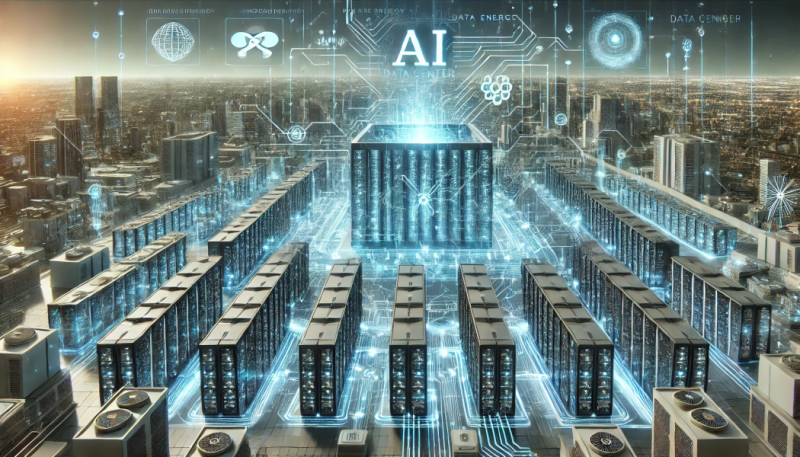The Rising Energy And Infrastructure Demands For AI Data Centres

Categories :
How does this growth affect the global climate? Data centres, powering AI applications, are consuming more electricity than ever before. The International Energy Agency highlights that global data centre energy use will more than double by 2026, largely due to AI.
Artificial Intelligence (AI) is changing many aspects of our lives, but it’s also causing a big increase in energy use. Data centres, where AI operates, are now using more electricity than ever before. According to the International Energy Agency (IEA), global energy consumption by data centres is expected to more than double from 2022 to 2026, with AI being a major driver of this increase.
Data centres are full of computer servers that run around the clock to store and manage data. They play an important role in supporting various online activities, from social media to financial transactions. AI Data centres use over 1% of the world’s electricity. The rise in AI has pushed their energy use even higher, as training and running AI models require much more power compared to traditional data centre operations.
A single query with AI like ChatGPT can use ten times more energy than a regular search. As tech companies compete to develop more powerful AI, data centre energy use could soon match the total consumption of entire countries like Sweden or Germany. This increase in energy and resource use is raising concern about its impact on climate change and local communities.
The Role of AI Data Centers in Modern Technology
AI data centers are crucial in supporting modern advancements, providing the necessary infrastructure to handle the massive amounts of data needed for AI to function effectively.
Growth of AI Technologies
Artificial Intelligence (AI) has seen tremendous growth, driven by advances in machine learning and deep learning. Machine learning enables systems to learn and adapt from data without being explicitly programmed. This has led to practical applications across many industries, such as Fraud Detection Systems used by financial institutions to identify suspicious transactions and Personalised Marketing strategies that target consumers with tailored advertisements based on their behaviour.
Deep learning, a more advanced form of machine learning, involves using neural networks to analyse large amounts of data through multiple processing layers. This technology supports highly complex applications such as Google’s DeepMind which has developed AI systems capable of mastering complex games like Go and StarCraft II, and Amazon’s Alexa, which processes voice commands to manage smart home devices and provide information. Another example is IBM’s Watsonx, which uses deep learning for natural language processing to assist in fields such as healthcare, where it helps in diagnosing diseases and personalising treatment plans.
Data Processing Needs
AI applications demand significant data processing and storage resources. Training deep learning models involves processing enormous datasets, which is crucial for the AI to learn and make accurate predictions. For example, self-driving cars rely on deep learning to process real-time data from cameras and sensors to navigate safely. Similarly, Netflix’s recommendation engine uses vast amounts of viewing data to suggest content that users are likely to enjoy.
These data-intensive needs require robust data storage and processing capabilities, which are provided by data centres. Data centres house thousands of servers that manage and store this data, ensuring that AI systems have the necessary resources to function effectively. The rapid expansion of AI technologies has led to a corresponding increase in the number and size of data centres around the world, reflecting the growing importance of these facilities in supporting advanced AI applications.
Expansion and innovation of Data Centers for AI
Data centres are rapidly growing as more companies need space to handle vast amounts of data and AI processing. This expansion involves building new facilities and upgrading existing ones with better cooling systems and energy-efficient technology.
Increase in Data Centre Infrastructure
The rapid growth of AI technologies has driven a significant expansion in data centre infrastructure. To keep up with the increasing demand for data processing and storage, companies are both expanding existing data centres and constructing new facilities around the world.
For example, major tech companies like Amazon Web Services (AWS) and Microsoft Azure have been aggressively increasing their data centre footprints. AWS has launched new regions and availability zones to support the growing needs of its cloud services, while Microsoft has invested heavily in new data centres to enhance its Azure cloud platform. In Northern Virginia, known as "Data Center Alley," data centres have proliferated so rapidly that the region now houses the largest concentration of data centres in the world. Similarly, Google has been expanding its data centres across multiple continents to ensure global availability and reliability of its services.
This expansion is not limited to new builds; existing data centres are also undergoing significant upgrades to accommodate the growing demands. This includes the addition of more server racks, enhanced power supplies, and larger cooling systems to support the increased load.
Technological Upgrades
To handle the heightened demands of modern AI applications, data centres are incorporating several technological upgrades aimed at improving efficiency and performance.
One major upgrade is the implementation of advanced cooling systems. Traditional cooling methods, such as air conditioning, are being replaced with more efficient solutions like liquid cooling and immersion cooling. Liquid cooling involves circulating coolant through servers to absorb and dissipate heat more effectively, while immersion cooling submerges server components in a non-conductive liquid that transfers heat away from the hardware. For example, the company Submer provides immersion cooling solutions that can reduce energy consumption by up to 40%.
Another key advancement is the use of energy-efficient hardware. Data centres are increasingly adopting high-efficiency servers and solid-state drives (SSDs), which consume less power and generate less heat compared to traditional hard drives. For instance, NVIDIA's latest GPUs (graphics processing units) are designed to deliver higher performance with significantly lower energy consumption compared to previous models. These advancements help reduce the overall energy footprint of data centres while maintaining or improving their computational capabilities.
Renewable energy sources are being integrated into data centre operations to reduce reliance on fossil fuels. Many data centres are now powered by solar, wind, or hydroelectric energy, reflecting a broader industry trend towards more sustainable practices. Companies like Google and Facebook have committed to running their data centres on 100% renewable energy, which helps mitigate the environmental impact of their operations.
Impact of Data Centers on energy consumption
Higher Energy Demands
AI-driven data centers have significantly increased global energy consumption. For example, the International Energy Agency (IEA) reports that data centers now account for over 1% of global electricity use. This is largely due to the energy-intensive nature of AI technologies. Training large AI models, like those used for language processing and image recognition, requires massive computational power.
According to David Porter from the Electric Power Research Institute, a single ChatGPT query consumes about ten times more energy than a standard Google search. As AI applications continue to grow, so does their energy footprint, with estimates suggesting that data centers could consume as much energy as entire countries, like Sweden or Germany, within a few years.
Challenges in Energy Supply
The rapid rise in energy consumption poses significant challenges for energy supply. Many existing power grids are struggling to keep up with the increasing demands of data centers. For instance, Microsoft’s expansion into AI has led to a 30% increase in its greenhouse gas emissions, highlighting the strain on energy resources.
Localities like Northern Virginia, which houses a large concentration of data centers, face potential issues with power shortages and the need for upgraded infrastructure. The growing energy demands from data centers put additional pressure on power grids, leading to concerns about potential brownouts and the need for substantial investment in energy infrastructure to ensure reliable and sustainable power supply.
Sustainability Challenges and Solutions
The rise in energy consumption associated with AI data centres poses significant sustainability challenges:
Environmental Impact: The surge in energy consumption by AI data centres has raised significant environmental concerns. As these facilities consume more power, their carbon footprint expands, contributing to climate change. For instance, the increased energy demand can lead to higher greenhouse gas emissions if the power is derived from fossil fuels. This poses a challenge for the tech industry, which is under growing pressure to align with global sustainability goals and reduce its environmental impact.
Sustainability Initiatives: To combat these environmental challenges, many data centres are adopting various sustainability measures. A major step is the shift towards renewable energy sources, such as solar, wind, and hydroelectric power, which helps to reduce reliance on fossil fuels. Additionally, data centres are investing in advanced technologies to enhance energy efficiency. For example, improvements in cooling systems—like liquid and immersion cooling—can significantly reduce energy usage. Furthermore, AI-driven solutions are being employed to optimise power consumption and improve operational efficiency, helping to minimise waste and reduce overall energy requirements.
Future Directions: The future of AI data centres will likely involve further advancements in sustainability. Green data centre designs are expected to become more prevalent, incorporating eco-friendly materials and energy-efficient layouts. Innovations such as advanced cooling technologies and improved hardware efficiency will also play a crucial role in reducing the environmental footprint of these facilities. As the industry continues to evolve, ongoing efforts to enhance sustainability will be essential in balancing the growing demands of AI with the need to protect the environment.

Pallavi Singal is the Vice President of Content at ztudium, where she leads innovative content strategies and oversees the development of high-impact editorial initiatives. With a strong background in digital media and a passion for storytelling, Pallavi plays a pivotal role in scaling the content operations for ztudium’s platforms, including Businessabc, Citiesabc, and IntelligentHQ, Wisdomia.ai, MStores, and many others. Her expertise spans content creation, SEO, and digital marketing, driving engagement and growth across multiple channels. Pallavi’s work is characterised by a keen insight into emerging trends in business, technologies like AI, blockchain, metaverse and others, and society, making her a trusted voice in the industry.










